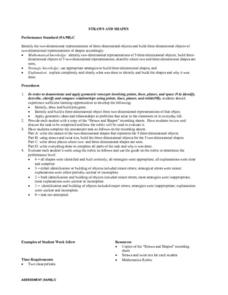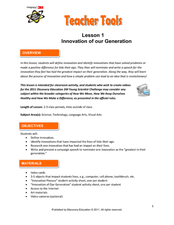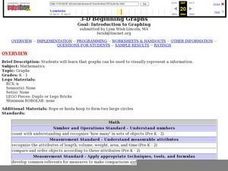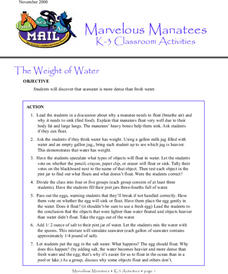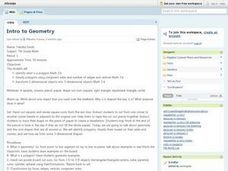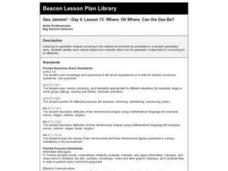Curated OER
Graph It
First graders collect classroom data (such as mode of transportation used to get to school) and prepare a pictograph to interpret the information.
Curated OER
Circumlocution
Young scholars describe unfamiliar objects and situations using existing vocabulary and circumlocution techniques.
Curated OER
Straws and Shapes
Students investigate the concepts related to observing two dimensional objects. They also build three dimensional objects using the two dimensional objects. The students give an oral or written explanation for how the pieces fit together...
Curated OER
Innovation of Our Generation
Students brainstorm on the different innovation in their lives today. In this technology lesson, students research one innovation and prepare a speech to convince their classmate to name it the "Innovation of our Generation." They...
Curated OER
Form, Story, and Function: Then and Now
Students compare the function and decoration of everyday objects from ancient Greece and today's world. They complete a chart imbedded in this lesson plan that enables them to compare today's objects to objects of the past.
Curated OER
Pattern And Design in Nature
Young scholars observe natural objects carefully and note intricate design and structure beyond surface form.
Curated OER
3-D Beginning Graphs
Students explore the concept of big and small. They collect objects from the classroom, sort them by size, and create a graph using Duplo stacking blocks.
Curated OER
Get a Clue: What is There and What Isn't
Students practice the ability to examine and analyze evidence and extract information that eventually leads to deductive conclusions. After evaluating the objects discovered in a box, students write a one-page reflection paper of their...
Curated OER
3-D Figures Part 2
Students work with three dimensional objects. In this geometry lesson, students examine models of spheres, cones, cubes, prisms, and pyramids, and identify them by their edges, vertices, and faces.
Curated OER
The Weight of Water
Students participate in an experiment about the weight of water. They work together to discover that seawater is more dense than fresh water. They also determine which objects float and sink.
Curated OER
Graphs
Students identify the difference between two objects: a glove and a mitten. Those who like gloves raise their hands and receive a glove outline to color and cut out. Then those who prefer mittens will raise their hands and receive a...
Curated OER
Intro to Geometry
Seventh graders identify a polygon and classify them using congruent sides and number of edges and vertices. Students transform two dimensional objects into three dimensional objects.
Curated OER
Create An Illuminated Alphabet Word Book
Students develop a class alphabet book. In this visual arts lesson plan, they draw a letter of the alphabet that is illustrated with animals or objects in the style of medieval illuminated alphabet books. They write a sentence about an...
Curated OER
Geo Jammin' - Day 4, Lesson 13: Where, Oh Where, Can the Geo Be?
Students listen to a story "My Crazy Dream" with an intent to identify shapes in ordinary objects. They raise their hands when they've heard an object whose shape they can identify. They discuss their findings.
Curated OER
How Far Can You Throw?
Sixth graders take a turn throwing the basketball and softball. They measure the distance in feet and inches between the starting and landing points of the balls. The recorder will record the distance each ball was thrown next to each...
Curated OER
Orienteering II
Students name the parts of a compass and comprehend the function of each part. They define paces and tallies and use them in a real world situation. Students are shown the proper use of radio terminology. They use a map and compass to...
Curated OER
Density, Iron, and Anemia
Students explain what factors determine density. In this physics lesson, students hypothesize which objects are less dense. They cite the importance of density in everyday life.
Curated OER
Simple Machines, Odd Machine
Students explore six simple machines and locate them operating in a compound machine. The simple machines are identified at a variety of stations set up in the classroom and continued by identifying the machines in their homes.
Curated OER
Perspectives
Seventh graders describe an event, a situation, etc. through the eyes of two people or two inanimate objects.
Curated OER
Solar System (Lesson 2)
Eighth graders identify the objects that make up the solar system. They define new vocabulary and practice using them. They discover that the sun is a star.
Curated OER
Natural Wonders of China And Japan
Students identify some of the attributes of China and Japan and compare and contrast the way Chinese, Japanese, and American artists represent nature in art. The lesson is for upper-elementary classrooms.
Curated OER
Native Americans - People of the Plains
Students explore Plains Indians and practice computer skills by reading creation and migration stories on People of the Plains CD-ROM, and watching Plains video. Students examine village life of Plains Indians, and view different...
Curated OER
Symmetrical Journals
Young scholars examine the concept of symmetry by studying the symmetry of symbols in a wall painting and creating journals with a symmetrical design. After a class review of symmetry and identifying the line of symmetry in several...
Curated OER
Create a Compass Instructions for Teachers
Students, who are teachers, discover how to make box and water compass in their classrooms. They describe the scientific principles that are involved in making and using a compass.




